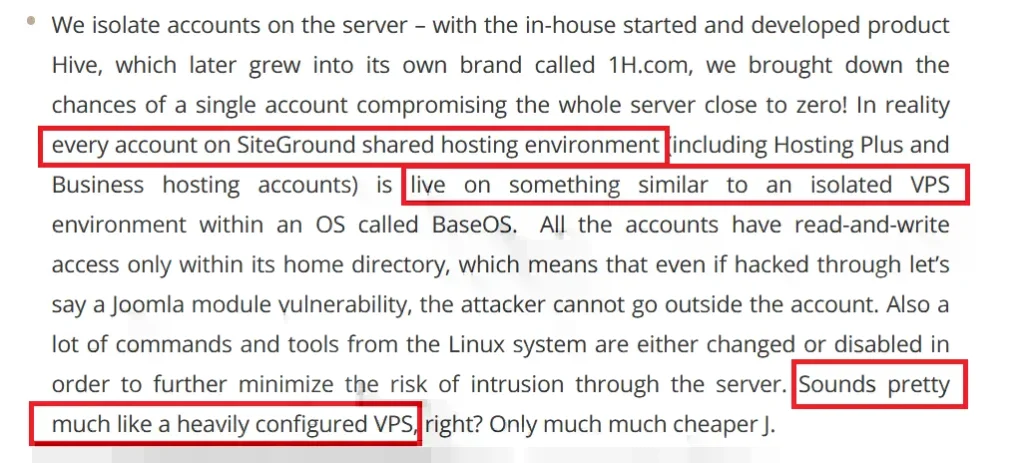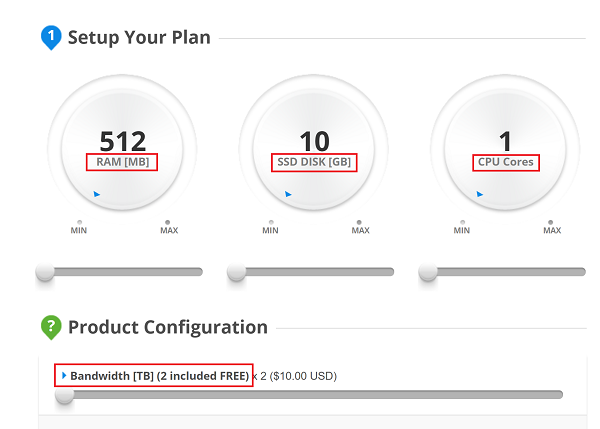Many web hosts exploit the fact that “cloud hosting” doesn’t have a standardized definition. So they just use it to sell ordinary shared hosting. Here are the real differences between the two, along with the benefits and disadvantages of cloud hosting and shared hosting.
Table of Contents:
Cloud Hosting vs Shared Hosting: Pros and Cons
For this section, I’m using the term “cloud hosting” to mean a VPS.
Cloud Hosting: The Good
- Dedicated resources
- Can scale RAM, CPUs and more
- Often have more control over the server
Cloud Hosting: The Bad
- More expensive than shared hosting
- Management is more complicated
- Customer support can only help with basics
- Each configuration is different
Shared Hosting: The Good
- Easy to set up. Easy to use
- Cheap
- Customer support can help you more
- Standardized
Shared Hosting: The Bad
- You share resources with everyone on the server
- Can’t scale resources to grow with your site
- Strict restrictions over what you can do
In short, cloud hosting is for advanced users, whereas beginners should stick to shared hosting. Even sophisticated users can feel dragged down by the amount of management that cloud hosting requires.
Benefits of Cloud Hosting
Here are the biggest benefits of cloud hosting over shared hosting.
Cloud Hosting Has Dedicated Resources
Compared to shared hosting, you typically get your own resources like RAM and CPU power with cloud hosting. This isn’t always the case when hosting providers call ordinary shared hosting as “cloud hosting” just because of virtualization technology.
Cloud hosting typically gives you all the resources on the server compared to shared hosting.
But in general, even web hosts that do this place your site on less dense servers. A good example of this is Hostgator. Hostgator’s cloud hosting doesn’t refer to a VPS or dedicated resources, but it’s still better than shared hosting because the servers have fewer accounts and there are many additional benefits like static data caching.
But when cloud hosting refers to a VPS or dedicated servers, then you get the full share of the listed resources. Before you purchase cloud hosting, make sure that you know what kind it is – there’s no standardized terminology and each web host has its own interpretation.
Cloud Hosting can Scale Resources Automatically
Since cloud hosting uses virtualization technology, it’s easy for web hosts to scale your resources without taking down your site or taking time to migrate it.
Some hosting providers can even scale your site in real-time as traffic increases or decreases. They can allot extra RAM and CPU power on the fly transparently. One example of this is the Nexcess WooCommerce plan, where the auto-scaling technology lets you handle bursts of traffic up to 24-hours per month for free. This kind of scalability isn’t possible with ordinary shared hosting, where you’re stuck with the resources on hand on the server that you share with everyone else.
Another example of a cloud service that scales resources is Liquid Web Cloud Sites. You pay a (high) flat fee, and you can host as many websites as you want, and Liquid Web will scale your resources to match your traffic load. It’s one of the few examples of a real cloud product.
Cloud Hosting can Have On-Demand Billing
Another benefit of cloud hosting is that your provider can bill you only for resources used, as opposed to a flat fee every month.
With cloud hosting, you can pay only for what you use.
This can be a double-edged sword, as if your server usage spikes, you can be hit with unanticipated bills. But there are ways to keep that in check by placing a cap and smart monitoring. On the other hand, you might pay only a fraction of what you would ordinarily pay if you were renting out a full-fledged VPS. If you quickly spin up a virtual machine on DigitalOcean for example, the cost to run the server for a few hours will be just a few pennies. This kind of flexibility is unheard of in shared hosting.
Of course, not all cloud hosting providers let you do this, because of the lack of standard terminology. But it’s important to know that it’s possible with some of them. You will never get this with shared hosting.
Cloud Hosting Gives you More Control Over the Server
With cloud hosting, you can typically do more with the server than you can with shared hosting. This is because you own the resources and don’t have to share them with anyone else. Again, there are exceptions with those hosts that use the term loosely.
With cloud hosting, you get SSH access and full control
On shared hosting, you have severe restrictions on usage because the web host doesn’t want your site to adversely affect the others. So there are limits on I/O usage, CPU usage, and RAM. You often don’t have SSH access, which further limits the installation of software on your server and testing things out. For example, if you want to use the New Relic monitor on your site, you have to request your host to do it for you – and they probably won’t.
But on cloud hosting, you can access the server via SSH and more or less change the software configuration as you see fit. Because you own the resources and can’t impact anyone else’s site, you have a lot more freedom than you have with shared hosting.
Benefits of Shared Hosting
Here are the benefits of shared hosting.
Shared Hosting is Cheap, Unlike Cloud Hosting
This is the biggest difference between the two from a customer’s point of view. Shared hosting is much more inexpensive than cloud hosting. Of course, if “cloud hosting” is used as another term for “VPS”, then it’s easy to see why it costs more.
Shared hosting has fewer features, and is thus cheaper than cloud hosting.
But even when it more closely resembles traditional hosting, the cloud tends to be more expensive than shared hosting. The reason is that providers tend to pack in a lot more features than ordinary shared hosting when they call it the cloud. This includes backups, malware scanning, and less dense servers. A great example of this is Hostgator’s cloud service – even though it’s not a VPS, it’s a much higher-end offering than their shared hosting.
Here’s a complete web hosting comparison table, where you can see how cheap regular hosting is. You can get started for as little as $2.57/m. By contrast, the Hostgator cloud plan is $4.95/m. That’s almost double!
Shared Hosting is a Lot Easier to Manage
With cloud hosting, you need to make a lot more decisions about what’s right for your site. In the case of a cloud VPS, you need to set it up, install your software and make all the decisions regarding normal server management. This is one of the reasons why it’s so hard to migrate from shared hosting to a VPS.
If you’re new to hosting, shared hosting is simpler than cloud hosting.
On shared hosting, you don’t need to make any decisions regarding the infrastructure. Your server is set, your control panel is already configured, and you can enable and disable PHP plugins with the click of a mouse. If your host has automatic backups, then it’s easy to restore them from within the panel. You don’t have to configure the backup schedule on your own.
Even for “non-VPS” cloud services, you have to pay attention to how many resources you’re using and adjust them accordingly depending on your traffic. For example, with Nexcess, you need to decide whether you want to pay for the advanced auto-scaling plan. On shared hosting, you don’t have to bother about any of this. It just works, and you don’t have options. Some people might not like this, but for others, it’s a boon.
Unlike cloud hosting, on shared hosting, you don’t need to be worried about server crashes. It’s your host’s job to ensure that the server stays up. On cloud hosting, however, everything is your responsibility if it’s a VPS-like service. Of course, this doesn’t apply when talking about non-VPS like products.
What is Cloud Hosting?
Cloud hosting means that none of the following are tied down to a single machine:
- CPU
- Memory (RAM)
- Hard Disk Space
- Bandwidth
Cloud hosting spreads your website across several servers instead of just one. There’s no one server on which your site is hosted. So you don’t shop by disk space etc like normal hosting plans, because there are none! Instead, you can increase or decrease the resources available to you on the fly.
Now that you understand the basic idea, let’s see how it differs from shared hosting.
Cloud Hosting Is Usually a VPS – But Sometimes Shared Hosting
Most of the time, the word “cloud hosting” means a VPS server. A server where it’s easy to upgrade/downgrade resources. Web hosts like SiteGround and Liquid Web use the term in this manner.
But sometimes, cloud hosting is used to designate supercharged shared hosting. With Hostgator cloud hosting, for example, your get less crowded servers, along with things like dynamic page caching and a CDN. NameHero is another web hosting provider that uses “cloud hosting” to mean advanced shared hosting, with malware scanning, a LiteSpeed web server, and backups.
List of Web Hosts that Use “Cloud Hosting” to Mean a VPS
These are the hosts that use the term cloud hosting to designate a VPS-like service:
- SiteGround
- Liquid Web
- A2 Hosting
- Exabytes
- RoseHosting
- DigitalOcean
List of Web Hosts that Use “Cloud Hosting” to Mean Shared Hosting
- Hostgator
- NameHero
As you can see, most hosts these days use “Cloud Hosting” to mean a VPS.
SiteGround Exemplifies This Confusion
If you want to see how much confusion the term “cloud hosting” has caused, look no further than SiteGround. For a long time, SiteGround branded its shared hosting “GoGeek” plan as a lite VPS. The CEO of SiteGround Tenko Nikolov himself likened the shared hosting plans to a VPS, thanks to their site isolation technology. Here’s a screenshot of the relevant quotes:

Several of SiteGround’s own articles referred to their shared hosting GoGeek package as a “Semi-dedicated” plan. However, SiteGround later changed that branding, erasing all references to their VPS. Now SiteGround’s official position is that they have no VPS. Instead, all queries for “SiteGround VPS” now lead to their cloud hosting product. SiteGround was so desperate for people to forget, that they asked me to take down a review where I posted screenshots of their earlier branding.
In short, hosting providers have been struggling to define “cloud hosting” for a while. The consensus now seems to be that cloud hosting is a VPS – with the only difference being that it’s no longer tied down to a single server.
“Cloud” Shared Hosting Doesn’t Exist
I know what you’re thinking. Why can’t we have “shared hosting” that simply scales as the site grows? Why not have cloud plans that are cheap when traffic is low, and which scale up when more traffic comes in?
Unfortunately, this will not happen. Cheap shared “cloud” hosting will never truly exist, because it’s not enough to say “scale up when traffic increases”. When you pay for shared hosting, you’re paying for a certain number of resources. The more you pay, the faster your site becomes. Technically, there’s no limit to how fast you can make your site!
So what will cloud shared hosting really give you? No one knows. It’s very ill-defined. Even though there are web hosts like DreamHost, that have just one shared hosting plan, they too have limits and will happily kill processes on your site that are taking up to much CPU time.
The Cloud Allows Unlimited Customization
Cloud technology allows web hosts to provide you with options like never before because they’re no longer bound by the constraints of a single server. So a hosting provider like RoseHosting can offer complete customization of their servers like this:

Cloud hosting allows servers to pool their resources together, to create massive virtual machines, that wouldn’t otherwise be possible.
Why the Confusion Between “Cloud” and “VPS”?
The explanation above shows the reason for the confusion between “cloud” and “VPS” offerings. The cloud allows you to create virtual machines…which are nothing but Virtual Private Servers!
Many web hosts themselves are unsure of what to call their offerings! Some providers like SiteGround, don’t have a VPS offering at all and instead refer their customers to their GoGeek plan. Others simply show the same plan for both cloud hosting and VPS hosting.
Early Confusion with Hosts like GoDaddy
When the term “Cloud Hosting” was new, everyone was cashing in on the trend. GoDaddy for example used to promote cloud hosting as the next great thing at prices even cheaper than shared hosting plans! I remember thinking at the time that this was absurd. Their promises were too good to be true. And indeed, things have settled down since then. Hosting providers have realized that cloud hosting is a separate offering that’s a good fit for some people and a bad fit for others.
So let’s understand quickly what cloud hosting is, before exploring its differences compared to regular hosting.
Increase Hardware Resources on the Fly with the Cloud
With traditional hosting, your hardware resources have to keep up with your traffic. As your site grows, you need more memory, more disk space, and more bandwidth. After a certain point, you need to switch to a higher, and more expensive plan to keep up.
Cloud hosting removes the need to change plans. You can simply add more hardware like memory etc as you go along. This is the benefit of not running from a single machine. Everything is in the cloud, and provisioning resources can be done in minutes.
This makes it difficult/impossible for a cloud server to go down from a sudden short-term DDoS attack for instance. Since you can automatically scale your resources, you always have as much power as you need. The downside to this of course is that if you’re not careful, you can rack up huge bills 🙂
The Cloud Removes a Single Point of Failure
No matter how reliable a hosting service is, there will be some periods of downtime. Either for server maintenance, or some configuration error, or due to a misbehaving website on the same server. But since your cloud-hosted website isn’t sitting on just one machine, your site will never go down. If there’s some local problem, another server will take up the load. So the uptime of a cloud service should be close to 100%. No issues with scheduled maintenance. The cloud is always on.
It also means that your data is always mirrored to different locations. A server crash won’t wipe everything out. It’s always backed up across multiple data centers!
Cloud Hosting is more Expensive than Shared Hosting (Obviously)
It should be obvious by now that cloud hosting requires a lot more management and technical expertise compared to ordinary shared hosting. The benefits and additional resources you use make cloud hosting far more expensive compared to traditional hosting. Now that the initial excitement over cloud hosting has settled down, the price difference between the two types of plans is clear.
You need to opt for cloud hosting only if you want the power, reliability, and flexibility it offers. Choose cloud hosting if your site needs to dynamically manage its resources and if you’re not comfortable with even a moment of downtime. The cloud can provide you with an extremely powerful and robust website that’s difficult to take down. And it will scale with your business as it grows.
On the other hand, if your website is just starting and has fewer than say 100,000 visitors a month, another hosting plan will be better for you. You can always migrate to cloud hosting later on when you see the need!

Speak Your Mind